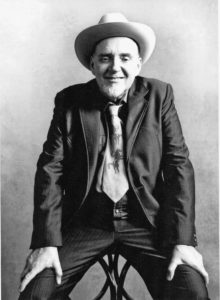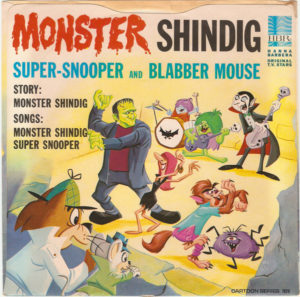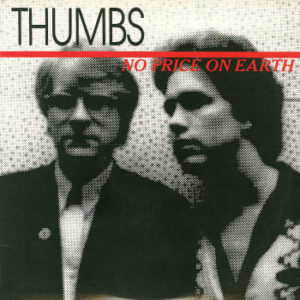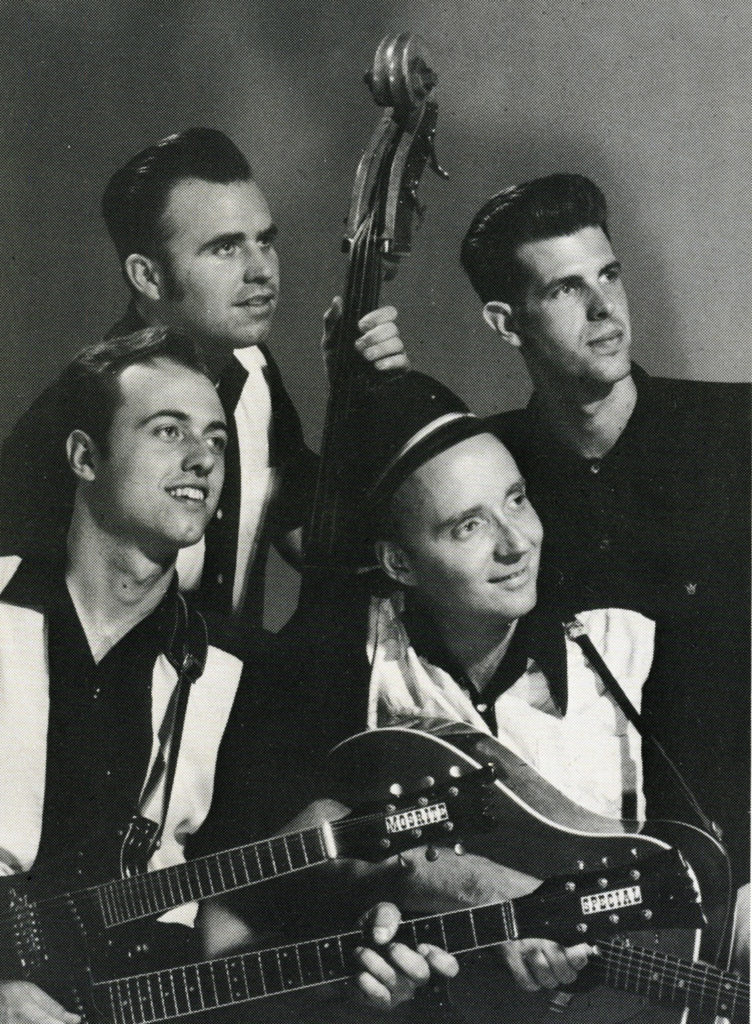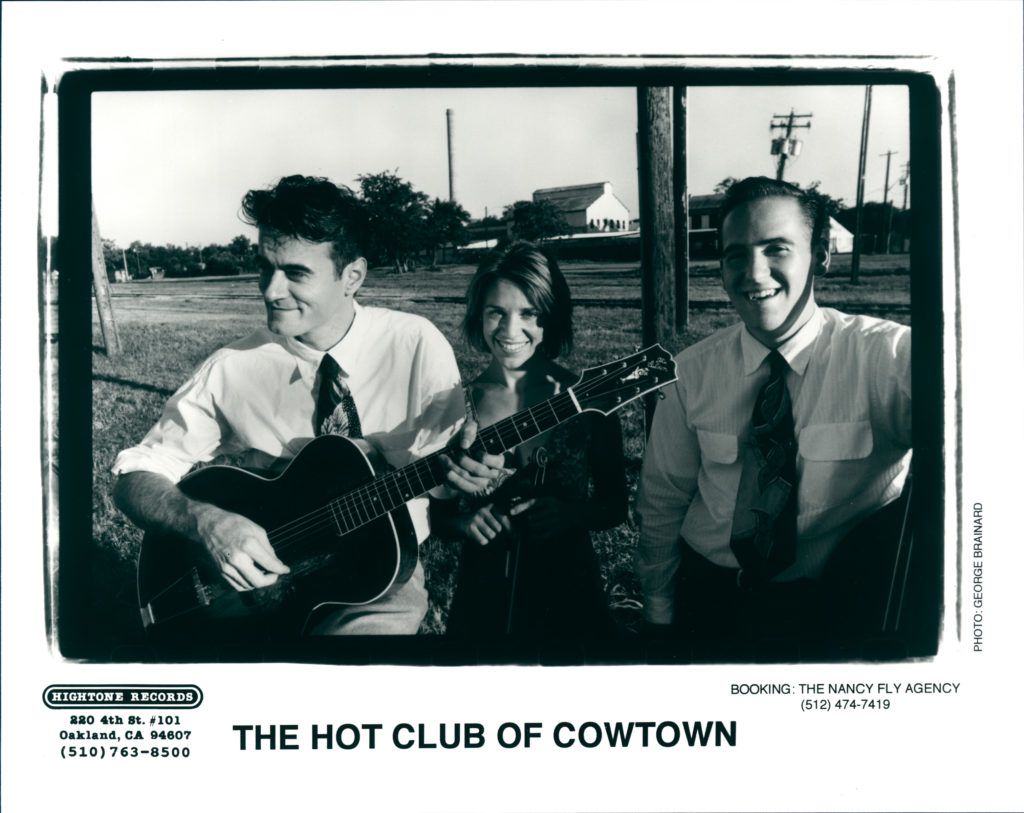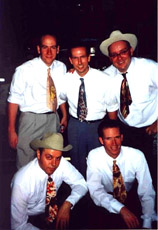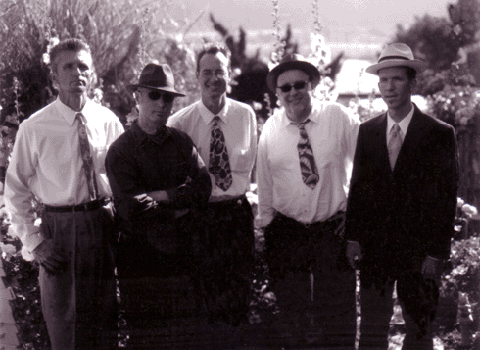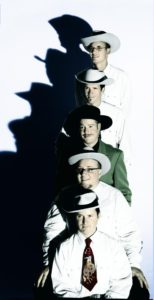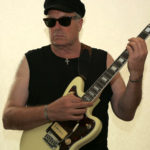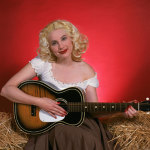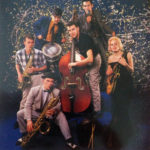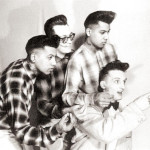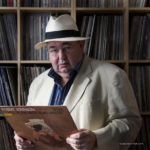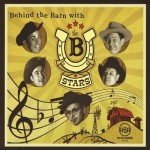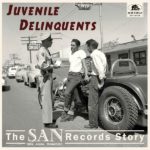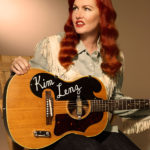He played with the Dave & Deke Combo in the 1990s and was part of the resurgence of American Rockabilly along with other bands like Big Sandy, High Noon, and Go Cat Go. He produced records, including the best album by the Hot Club of Cowtown, and wrote songs with them, too. He played drums with the Untamed Youth and was offered a place in the Cramps. He released the best Western Swing album since the genre’s heyday and won the 2020 Ameripolitan Music Award for Best Western Swing Vocalist. When he’s not leading his hot jazz combo, the Hot House Gang, he continues to play drums with the Lucky Stars. All these achievements — and more — raise the question: who is Dave Stuckey?
Dave Stuckey was born in October 1959 in Kansas City, Missouri. Undoubtedly, the city’s prestigious musical past influenced young Stuckey’s tastes and musical future. “Kansas City is an easy place to get interested in music history… As you know, Kansas City has a terrific music past, from the great jazz clubs at 12th & Vine streets, Joe Turner, Count Basie, and Charlie Parker to the country/rockabilly label Westport Records. They even had a ‘Barn Dance’-type show in the ’30s and ’40s called ‘The Brush Creek Follies’! It was a wide-open, New York type of town back then — during the Prohibition Act in America, Kansas City had more than 300 Speakeasy’s! As a kid, one of the first things I did when I got my driver’s license was head downtown to Union Station, where you could still see the bullet holes from a shootout Pretty Boy Floyd had with Federal Agents when he was trying to spring an accused bootlegger in custody. That gives you a sense of the great ghosts that are floating around in Kansas City.”
But well before discovering Rockabilly, Hillbilly, or Jazz, his tastes were those of someone his age. “The first record I remember getting is ‘Sugar Sugar’ by the Archies — It was a cardboard record cut out of the back of a box of cereal! The first 45 record I bought myself was “Monster Shindig” (which seems logical for someone who later participated in a documentary on Bela Lugosi, developed a friendship with the Cramps, and recorded songs for Roger Corman, but already, I say too much – Ed) on Hanna Barbera Records, a kid’s label. The first LP? Well, there were actually three. There was a department store in Kansas City that sold LPs; I had some money from cutting grass or something and bought ‘Golden Bisquits’ from Three Dog Night, ‘Meaty Beaty Big & Bouncy’ by the Who, and Creedence Clearwater Revival’s ‘Green River.’” He then began to develop a taste for country music from the mid-60s, thanks to a dinner, The Skyline, which his grandparents frequented. But as he explains, it is the radio that played an essential role in his culture: “the real formative medium for me was listening to Top 40 radio on WHB, one of the first 3 top 40 stations in the US I was pretty well obsessed with the station and would often listen to my little portable under the covers late into the night…”
Around age 10, he received his first guitar (a Harmony Patrician) and, later, in high school, started playing drums when the bands he played in rehearsed at his house. Later, he also tried his hand at bluegrass banjo when he was around 17-18 years old.
He formed his first band in Junior High School. “We didn’t have a bass player… but still, if we set up in the driveway and played Deep Purple cover songs, the girls still hung around.”
The guy at the counter said, ‘You think this stuff is wild — you should try this’. He reached behind the counter and pulled out the ‘Chess Rockabillies’ LP that had just come out… I took it back to the dorm, and it really blew my mind… I mean, really! Rusty York’s ‘Sugaree,’ G.L. Crockett’s ‘Look Out Mabel’ — I was on the ceiling!
A few years later, when Punk emerged, the teenager immediately adopted the genre. “I was in high school when Punk first came around and was completely hooked by it. Kansas City was fairly tapped into it, believe it or not — there was a record store there (Caper’s Corner) owned by the brother of actor Ed Asner, and it was pretty hip. They carried the first punk LP (“The Damned”), the Sex Pistols’ first 45 on EMI, and got the NME paper every week… when the Ramones first came to town in ’77, Capers had an in-store appearance the day of the gig.” Punk led him to discover a genre that would definitively change the course of his life. “In my first year of college (in Denver, Colorado), I discovered an even better store called Wax Trax. It was a treasure trove of new and used records, 45’s, and LP’s. At any rate, in 1978 I was buying some punk 45’s or something one day, and the guy at the counter said, ‘You think this stuff is wild — you should try this’. He reached behind the counter and pulled out the ‘Chess Rockabillies’ LP that had just come out… I took it back to the dorm, and it really blew my mind… I mean, really! Rusty York’s ‘Sugaree,’ G.L. Crockett’s ‘Look Out Mabel’ — I was on the ceiling!”
Lawrence, Kansas
Dave Stuckey continued his studies at Lawrence University of Kansas. There, he joined the Regular Guys, a Power-Pop group. “It was pretty fun for two reasons: it was the first band I ever played bars with (the first show I ever played with them was in a strip club, where we had to share the dressing room with the strippers!), and they let play me Eddie Cochran covers! We got to open shows for a lot of bands who were coming through Kansas City and Lawrence at the time, like Secret Affair and U2!”
In 1981, he made his first trip to California. While in Los Angeles, Stuckey became friends with Lux and Ivy from the Cramps. “I met them at a club when I was in Los Angeles in 1981, and we fast discovered we had the same interests in music, comics, movies, and all that.”
Eventually, Stuckey returned to Lawrence, where he produced an album for a group called Get Smart (not to be confused with the English group of the same name). Around the same period, he played for a band called Thumbs and appeared on their album No Price On Earth, which was reviewed in Rolling Stone magazine in 1982. Dave also played with a Rockabilly/Rock’n’Roll group called Dalton Howard and the Go-Cats. And for the completist, Pappy also drummed with a band named Start on their Tales Of Glory EP. “Lawrence was an incredibly fun time,” he sums up.
In 1984, Stuckey moved to Los Angeles for good and worked on various documentaries with Mark Gilman, the former singer of the Regular Guys. “That ties into my college degree in radio/TV/Film. When I graduated, I came out to Los Angeles to make documentaries with Gilman, who was a friend back in Kansas. We first did a 3 Stooges documentary called “The Funniest Guys in the World” (released in 1983), sold that, and then did the Lugosi docu (1986). And some other things. They’re pretty hard for me to look at now – I’ve learned a lot more about the production process since then — but we did get to meet and work with old Hollywood legends like John Carradine and Ralph Bellamy”. He also worked on editing video clips for Los Lobos (La Bamba) and Dwight Yoakam.
Callin’ all you cornfed dames
After nearly three years of good and – almost – loyal service as second guitarist, Kid Congo left the Cramps in September 1983 to reunite with his friends from the Gun Club. Lux and Ivy found themselves without a stable lineup for a few months. Following Congo’s departure, the second guitar slot was first occupied by Ike Knox (Nick’s cousin), then Click Mort. Eventually, Lux and Ivy asked Stuckey to join them. “I came out and rehearsed for shows, but ultimately decided not to take up their offer… We remained good friends. Actually, Lux and I used to go record-hunting together at a monthly Swap Meet in Pasadena, CA. I have to say that since he’s heard about everything, Lux turned me on to more fantastic 45s I never would have thought about otherwise. I’ve had some of the best times of my life record hunting with him — he turned me onto many, many great records.” Ultimately, Ike Knox returned for a while before being replaced by Touch Hazard, whose real name is Tim Maag (who will reappear further in this article).
Lux and I used to go record-hunting together at a monthly Swap Meet in Pasadena, CA. I have to say that since he’s heard about everything, Lux turned me on to more fantastic 45s I never would have thought about otherwise. I’ve had some of the best times of my life record hunting with him — he turned me onto many, many great records.
In 1986, in the credits of the excellent album “A Date With Elvis,” the watchful fan could read “‘Cornfed Dames’ based on the Novel by Dave Stuckey” The musician explains “The ‘Cornfed Dames’ thing was a gag — they got the title of the song from a little comic strip I sent them when I still lived in Kansas City, so the note on “A Date with Elvis” was a little thank-you.” Stuckey would participate a few years later in the demos that the Cramps recorded for the film Cry Baby. Although they didn’t appear in the movie (Dave Alvin and James Intveld got the job), the songs appeared on the B-side of the single All Women Are Bad under the title Cry Baby Suite (King Of The Drapes, Teenage Rage, and High School Hellcats). Stuckey concludes, “I really can’t say enough nice things about those guys…”
Meeting Deke Dickerson: the Untamed Youth and the Dave & Deke Combo
Dave Stuckey quickly became a member of the California music community. He played for a time with Russell Scott and met Lloyd “Lucky” Martin, with whom he played in the Bird Dogs with Randy Weeks on guitar. Stuckey also got in touch with Bill Miller of Kicks magazine. Bill’s wife was Miriam Linna, the Cramps’ first drummer. Both Miller and Linna also played in the A-Bones.
One day, Stuckey tried to reach Miller on the phone, but he wasn’t there. Instead, the man who answered was Deke Dickerson. Dickerson was on tour with the Untamed Youth and sleeping at Miller’s house. “Billy wasn’t home, but Deke was there, on a tour with his band The Untamed Youth. I already had their first LP, so we hit it off”. Dave and Deke shared the same interests and musical tastes. When Deke planned to leave Missouri to settle in California, the two future friends had the idea of forming a group. “Deke had suggested over the phone that we start a Hillbilly harmony-type rockabilly band, which sounded great to me. The original plan was to move the Untamed Youth to Los Angeles and have the hillbilly band as a side project, but it didn’t exactly work like that. When he decided to move out to California, he had hoped that the whole band would move out too, but as it turned out, Mace was the only one who made the trip. Once he got here, the Dave & Deke thing took off faster.”
However, even though Deke and Dave laid the groundwork for the Dave and Deke Combo, Dickerson did not give up on his idea of continuing the Untamed Youth with a new lineup.
Deke and Mace recruited Trent Ruane (ex-Mummies, Phantom Surfers) to play the organ and asked Dave if he could help them until they found a permanent drummer. “He asked, as a favor, if I could fill in on drums until he found someone permanent… and I wound up drumming for three years with them! It was great fun, actually. Since we tried hard to keep Dave & Deke ‘traditional’ (not too loud, not too rock), it was nice to be able to ‘blow off some steam’ with the Youth.”
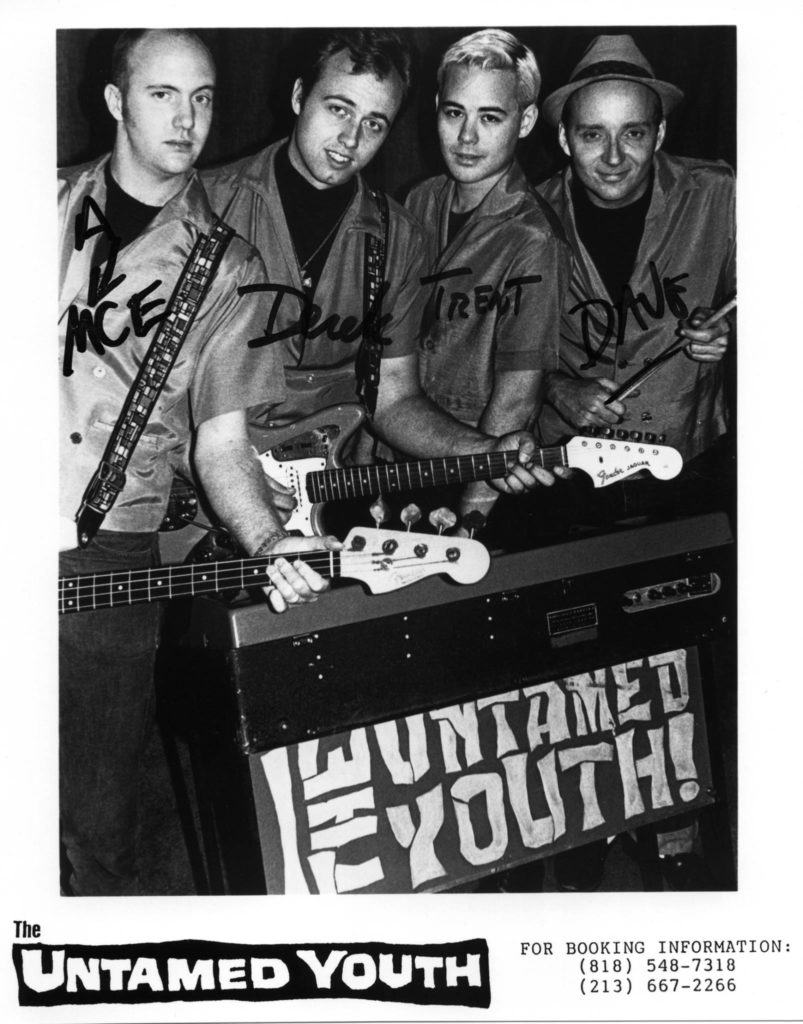
Thus, the Dave and Deke Combo was formed in 1991. The original lineup included Dave, Deke, Lloyd Martin, and Bobby Trimble, who also played with Big Sandy’s Fly-Rite Trio. “Since Dave & Deke and Big Sandy shared Bobby Trimble as a drummer for about a year (before Lance), we would often all pile into Wally Hersom’s van and head down to San Diego or up to San Francisco for shows… What a riot that was!” Lloyd Martin was responsible for programming at the Blue Saloon and played a part in developing the entire Californian “roots” scene. The Blue Saloon became a popular spot for rockabilly and surf music, with different bands performing on different nights of the week. “So there became a point when you could go to the Blue Saloon on any night of the week! Sunday night was Dee Lannon & Her Rhythm Rustlers, Monday was Russell Scott & the Red Hots, Tuesday was Deke’s Untamed Youth spin-off band (called The Beatnik Bandits), Wednesday was Dave & Deke, Thursday was Big Sandy, and Friday & Saturday were usually touring bands like Sleepy LaBeef, Rudy Grayzell, Rose Maddox and Ronnie Dawson! With lineups like that, you can see how the scene was very big in Southern California.”
The Dave and Deke Combo differentiated from other bands by its more pronounced Hillbilly approach: with two singers who could perform solo or in harmony, two songwriters, a formidable guitarist, and a subtle and tight rhythm section, they quickly became a force to be reckoned with. They drew inspiration from artists such as Rusty and Doug, Homer & Jethro, Little Jimmy Dickens, the Farmer Boys, Joe Maphis, the Collins Kids, and various groups of brothers, real or not, such as the Paris or Everly brothers.
In April 1992, the group recorded their first cassette at Wally Hersom’s Wallyphonic Studio, titled Home Brewed Demos, which included the following songs: No More Cryin’ The Blues, Hey Mae, Laurie Ann, Red Headed Woman, Moonshine, This is It, Baby’s Hot Rod, and Wild Woman.
In the middle of the year, Bobby Trimble left the Combo to fully concentrate on the Fly-Rite Trio, as their schedule was becoming increasingly busy (and would later include dates as Morrissey’s opening act in the fall of 1992). Lance Ray Solidays, formerly of The Gigantics, replaced him. This lineup went into the studio on September 26, still under the guidance of Wally Hersom, to record Jimmy Lee and Wayne Walker’s Love Me and Let’s Take A Little Ride, an original song. Together with Baby’s Hot Rod and Wild Woman from the previous session, the result was Hey Cuzzin’, the band’s first EP on No Hit Records (No Hit EP03).
In October, the Combo traveled to Europe and performed at the 9th Hemsby Rock’n’Roll Weekender.
In March of the following year, the quartet returned to Wallyphonic Studio, where they recorded Moonshine Melodies. Moonshine Melodies marked the thunderous, smashing, long-distance debut of the Dave and Deke Combo. At less than 28 minutes, with the longest track barely reaching three minutes, it’s a well-rounded affair. With no surprise, the setlist contains Hillbilly with a strong Rockabilly flavor, with a few boogies (talkin’ or not) thrown in for good measure and a good dose of novelty. The songs of Moonshine Melodies maintained the tradition of Hillbilly groups such as Rusty and Doug, Jimmie & Johnny, the Farmer Boys (of whom they cover I’m Just Too Lazy), etc. Even if Stuckey or Dickerson sang solo on some tracks, the emphasis was on vocal harmonies. Perhaps less evident on record, the Dave and Deke Combo also posed as heirs to artists such as Homer and Jethro, Lonzo and Oscar, or Cousin Jody, bringing a touch of humor to a scene that sometimes tended to take it a little too seriously. And like their illustrious predecessors, this apparent relaxation and humorous approach hid a high level from both a musical and artistic point of view. Even if the album contained a majority of covers (Sparkletones, Tommy Cassell, Little Jimmy Dickens, Jim & Rod), Stuckey and Dickerson proved that they were excellent songwriters whose original songs had no reason to be ashamed of the company of their illustrious elders. Better still, they gave the impression of being period pieces because they blended in so well with the selection, like Dickerson’s You Ain’t As Dumb As You Look or Stuckey’s Warm Lips (Big Trouble).
Dickerson’s work on the album positioned him as a successor to the great guitarists of the fifties, drawing clear inspiration from Joe Maphis, Merle Travis, and Grady Martin. However, although less flashy, Stuckey’s rhythm guitar was crucial to the mix, particularly evident in the instrumental Two Guitars No Waitin. The rhythm was impeccable, and Soliday’s drumming is noteworthy for its subtlety and sparing use of cymbals, a rarity among drummers.
A cover of Al Urban’s Lookin’ For Money was recorded at the same session but only saw the light of day years later on the band’s collection of rarities (There’s Nothing Like An Old Hillbilly, Bucket Lid 503).
Like many bands from that period, Dave and Deke tried to keep things period perfect. “One thing Big Sandy and I used to talk about a lot was how important it was to get the music ‘right.’ It’s not just robotic replication — but it was truly fun to write songs like the songwriters you love … and have people sometimes not know which was a cover and which was an original! That is always a great thrill for me because I have such respect for the great old-time writers…” explains Stuckey.
It was more than playing music; it was also paying respect and homage to an almost lost art and doing it well. As he told Isaac Guzman in the Los Angeles Times in 1995: “It’s just music done authentically without making a point of being a museum piece or a carbon copy. My personal hatred is bands who play a ‘50s-influenced kind of music, but they have a heavy metal drummer or a hippie bass player. I like music really pure.”
One thing Big Sandy and I used to talk about a lot was how important it was to get the music ‘right.’ It’s not just robotic replication — but it was truly fun to write songs like the songwriters you love … and have people sometimes not know which was a cover and which was an original! That is always a great thrill for me because I have such respect for the great old-time writers…
The group had no time to rest and left for Europe in May for a mini-tour, including The Rock’ N’ Roll Jamboree at the Casino Wohlen in Switzerland with High Noon, Big Sandy, and the Fly-Rite Trio, Ricky Cool & the Western All-Stars, and Jack Scott. They also returned to the stage of the Hemsby festival to back the Collins Kids. While they were in Great Britain, they took the opportunity to make a detour to Liam Watson’s Toe Rag studio and record a few songs (Hey Baby, Alamo, Made In the Shade). The latter, Cherokee Boogie and Tally Ho were released on the Stateside Rockabilly compilation (NV Records).
After their return, the group continued to play whenever and wherever possible. The live music scene was still lively then, and the Dave & Deke Combo easily found gigs. “We were all just happy to have places to play and people who were excited to come see us. It only lasted for a few years, and kind of drifted apart after Lloyd left the Saloon. It continued in a smaller form at other clubs like Jack’s Sugar Shack and the late, lamented Palomino Club but really petered out in the late ’90s. I think that’s just what happens with music scenes, by the way. Even the good ones never last! ”
In March 1994, the Dave and Deke Combo returned to the studio to record Chrome Dome, Carryin’ On, I’m Gonna Tell, and Laughin’ and Jokin’. Both I’m Gonna Tell and Laughin’ and Jokin’ remained unreleased until their release on There’s Nothing Like An Old Hillbilly. Still, Carryin’ On (by Dave Stuckey) and Chrome Dome (by Deke Dickerson) formed the new single from the group, released on their label Bucket-Lid. The Lucky Stars’ debut single was also released in 1996 on this same label. Stuckey explains the connection: “One of the very early Lucky Stars gigs was opening for the Dave & Deke Combo at the Doll Hut in Anaheim, CA. We loved them and were all friends, so after a while, we thought they should have something out. We had put the ‘Carryin’ On/Chrome Dome’ 45 on Bucket Lid Records, so we thought it might be fun to put the Lucky Stars record on that label.”
Sometime around the end of 1994 or the beginning of 1995, Lucky Martin moved and had to leave the group. Shorty Poole replaced him. The same year, the group recorded songs for a film produced by Roger Corman called Not Like Us. Those songs also appeared on the rarities album.
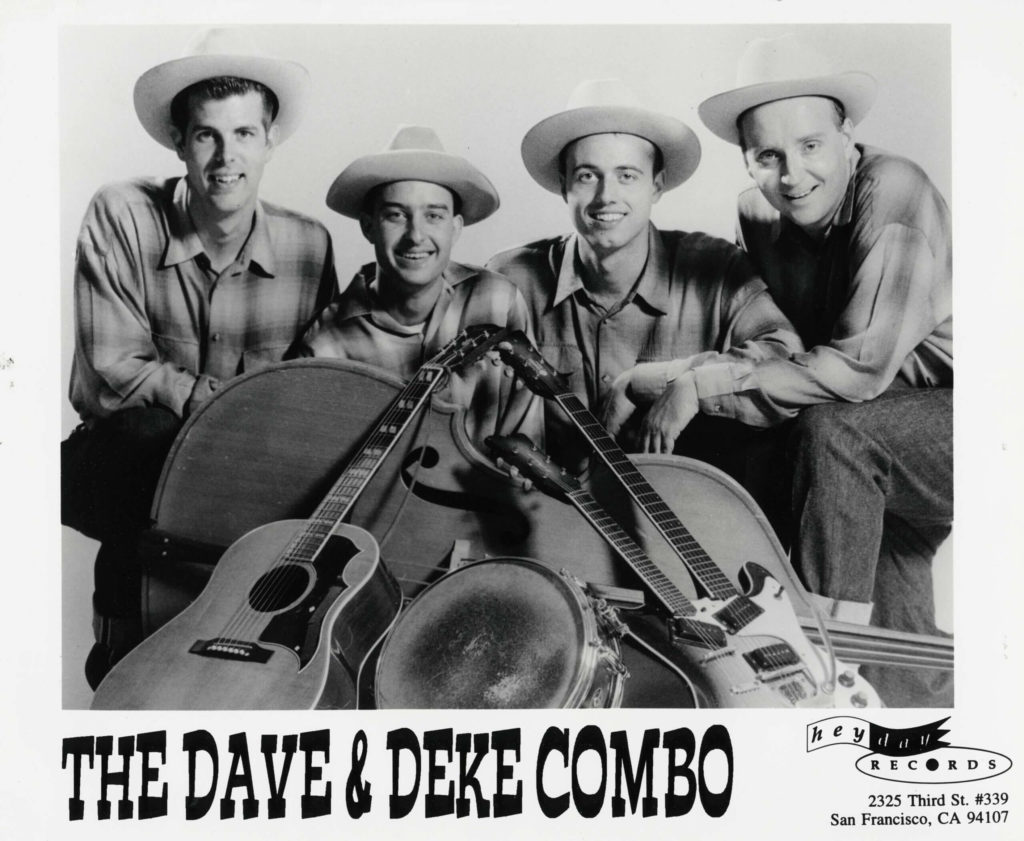
The Dave and Deke Combo took advantage of a tour in Finland to record two titles under the supervision of Janne Haavisto (member of Laika and the Cosmonauts and producer of High Noon’s Show and Dance): Chew Tobacco Rag and Twin Guitar Special, the latter with Lester Peabody (Hal Peters, Barnshakers) on second guitar. The single was released on Goofin’ Records (Goofy 552).
The group also recorded a song called Bear Creek Boogie to celebrate the twenty years of the Bear Family label. Yet, of course, the main event was the recording of the group’s second, unfortunately, last, album for Heyday Records.
Tim Mag, also known as Touch Hazard, joined Wally Hersom to help him record the album. As we saw, he had briefly played with the Cramps and was also a member of the Lucky Stars. When you listen to Hollywood Barn Dance, you can tell it sounds more like an extension than a companion to Moonshine Melodies. The sound is slightly cleaner (I said slightly). You can feel that the group has evolved, and the dynamic between each member seems different in Hollywood Barn Dance compared to Moonshine Melodies, which gives the impression of a more collective effort. The differences that led the group to separate shortly after began to appear on Hollywood Barn Dance. In other words, although the album includes moments of symbiosis like on Moonshine Melodies (Let’s Flat Get On It, Going Steady With The Blues, Deke’s Hot Guitar, or their cover of Ray Campi’s Let Go Of Louie), the personalities of the two leaders assert themselves. It seems that each of the two singers has found his way. Stuckey, who takes the lion’s share in terms of songwriting, tries to keep the group in a traditional line, whereas Dickerson, with his guitar sound and some of his compositions (No Good Woman), leads the group toward a more Rock’n’roll style. It’s very subtle, but let’s just say that Stuckey is pre-1956 and Dickerson post-1956. It doesn’t mean Hollywood Barn Dance is less good than Moonshine Melodies; it’s just partially different. All those elements, and probably things that are not our business, led the band to split in 1996. Dave’s take on the band’s split: “I think the main reason was that Deke wanted to do his own thing – and I understand that… I found that the more I played, the more ‘traditional’ I wanted to get… Deke has always had a deep love of Rock’n’Roll (I mean real, 50’s Rock’n’Roll, of course, not the weird definition that exists today), along with other kinds of music. He wanted to ‘mix it up,’ and I just wanted to get more and more Hillbilly. I understand the conflict, for sure. It was too bad since the band was just beginning to really get some interest after the second CD… but some of us could tour a lot and some of us had day jobs. It was just one of those things. And while I didn’t want it to end at the time (since I felt that we had put a lot of work into it), if it hadn’t broken up, I would have never met Whit Smith, who is a huge influence on me, Elana, and all the other folks in Austin I’ve gotten to play with. Most of all, I’d have never gotten to play with Jeremy Wakefield, which I think is the most fun I’ve ever had.”
Albeit playing for a relatively short time, the Dave and Deke Combo had a lasting influence on the Rockin’ scene. As Bobby Horton perfectly said, “This music wasn’t played that well until three bands came along: Big Sandy and the Fly-Rite Trio, the Dave and Deke Combo, and High Noon. I believe those bands have really spearheaded this current scene and deserve a lot of the credit. They were writing original music and had great musicians in their bands.”
The Hot Club Of Cowtown
The Hot Club of Cowtown was formed in the second half of the 1990s. Whit Smith played guitar and sang, Elana Fremerman/James played the fiddle (and later joined on vocals, too), and T.C. Cyran played the double bass. Elana and Whit moved to San Diego around 1997, and it was there that Dave Stuckey met them through Sean Mencher (High Noon). “We got together, hit it off, and, with Shorty and Lance Ray, played the ’97 Greaseball Weekend in San Francisco, where we also backed the Collins Kids. Great fun. However, Whit and Elana were interested in continuing full-time with the Hot Club of Cowtown, so they moved on to Austin…” With Billy Horton (of the Horton Brothers, for whom Stuckey wrote Whole Lotta Nothin’ and I Guess I’m Just In Love) on double bass, the trio recorded their first album for Hightone in 1998.
The following year, Whit, Elana, and Billy called on Stuckey to produce Tall Tales, their second opus. “Man, was that fun! I was flattered that they asked. We all went up to New York and recorded it. I was very happy with the way that one turned out.” Stuckey and Smith co-wrote When I Lost You “over the phone, which isn’t ideal, but not much of a problem…”
Stuckey’s love for Jazz, which, through his previous formations, had remained in the background, could fully blossom. It shines through in the arrangements and compositions (Emily, which sounds much like Louisiana) and the various guests, including Peter Ecklund (Leon Redbone, Eddy Davis, Marty Grosz, and dozens of others) on the cornet. Stuckey later participated in the trio’s fourth album, writing Sleep and Paradise With You with Smith.
In 1999, “The Hot Guitar of Biller & Wakefield” was released. In addition to brilliant guitar and steel guitar duets, it contains three songs: one excellent tune (Steel Crazy) by Big Sandy and the presence of Dave and Deke on the other two.
Please Pass the Biscuits, Pappy
Stuckey had long dreamed of forming a Western Swing band, and this dream finally started to take shape almost by chance at the turn of the century. “How it happened was an unexpected surprise… I had gone to see Austin’s 8 1/2 Souvenirs in LA. They were a fantastic band, and Kevin Smith was playing bass for them. High Noon was one of those bands who had come out to California in the Blue Saloon days and were very good friends. Anyway, during the break, Kevin says, ‘You know what you and Jeremy Wakefield should do? You should come out to Austin; we’ll get two fiddles, two guitars, a piano, and drums. and record a version of (Bob Wills) ‘Whoa Babe’” I said ‘sounds like a winner to me!’ out there a few months later…We went to Billy Horton’s studio. Kevin and Billy got all the players together: Whit Smith and Dave Biller on guitars, Elana Fremerman and Eamon McLaughlin on fiddles, T. Jarod Bonta on piano, Lisa Pankratz on drums…Billy played a little bass as well. Jeremy and I called it ‘The Austin Dream Band’! We started messing around, and suddenly, we’d recorded five songs in an afternoon! It just clicked! We left with the idea of recording more tracks and putting it out… In the meantime, Hightone Records called me and asked if I wanted to put something out on their HMG label.”
The songs recorded with Kevin Smith include Whoa Babe, Dinah, Twin Guitar Special, and a western swing version of the Dave and Deke Combo’s Did Anybody Mention My Name. These songs remained unreleased until 2009 when Goofin released them on an EP (GREP 213). The remaining three, Nobody’s Sweetheart, Coyote Blues, and Some of These Days, found their place on the album. However, recording the album turned out to be complicated, as everyone was busy with their respective groups. It was not until a year later that Wakefield and Stuckey returned to Austin to finalize the recording. At the time, Kevin Smith was too busy, so Jake Erwin replaced him, and Stan Smith and Bob Stafford joined the lineup on clarinet and trombone, respectively. The album “Get A Load Of This” was finally released in 2000 and is one of the best contemporary Western-Swing albums alongside any Lucky Stars records.
The set list displays the band’s ability to blend the old and the new, featuring covers like Adolph Hofner’s I’ll Keep My Old Guitar, Benny Goodman’s Pick-A-Rib, Johnnie Lee Wills’ Coyote Blues, and standards like Whose Honey Are You, Nobody’s Sweetheart, and Some Of These Days, made famous in Western swing by Leon Selph & the Blue Ridge Playboys, Bob Wills, and Milton Brown. The album also features five originals penned by Stuckey, so good that it’s hard to tell whether they’re from 1946 or 2000. The album showcases the band’s unique sound and ability to keep the Western swing tradition alive, and Billy Horton’s flawless production manages to capture the band’s energy and authenticity in the studio.
Stuckey toured, mainly with Dave Biller, Jeremy Wakefield, Billy Horton on double bass, and Lance LeBeau on drums, to promote the album. He even went to Japan in 2001 for a few concerts, accompanied by the Rollin’ Rocks, a Japanese group.
Drummin’ pappy
However, Dave Stuckey did not remain inactive, even if he was not in front of the stage. Thus, he joined the Lucky Stars in 2002. “Sage was hard up for a drummer! Actually, they did have a vacancy, and he asked a few years later, and I’m still in it. I get to sing a little, play some drums, and have a few laughs.” More than 20 years later, he’s still in the band, having played on two albums with them.
He also joined the Bonebrake Syncopators, a band formed by DJ Bonebrake (drummer for X, here on vibraphone) with Wally Hersom on double bass, TK Smith on guitar, and Jeremy Wakefield on steel guitar. They played drummerless for a year or so, but when they decided to add drums, it was natural to ask Dave to join. The band’s style was eclectic, mixing traditional Jazz with a touch of Western Swing, Bop arrangements, and even Hawaiian tunes. Musically, imagine a cross between Red Norvo, Benny Goodman’s small formations, Jimmy Rivers, and a lot of Bop in between, and you will have an idea of the result. The group released That Da Da Strain in 2008. With three soloists, two singers, and a superb rhythm section, this album takes no prisoners. Subsequently, Jonathan Stout replaced TK Smith on guitar. The Bonebrake Syncopators then recorded an EP of songs by Cy Coleman, including The Best Is Yet To Come, described by Stuckey as “[one of] the hardest things I’ve ever tried to sing! Lots of modulations and key changes.”
When asked about his drumming, Stuckey cites among his influences drummers like Dave Tough (Benny Goodman, Artie Shaw, Eddie Condon), Ray Bauduc (Bob Crosby and the Bearcats, Jack Teagarden) or George Wettling (Red Norvo, Eddie Condon, Muggsy Spanier). “Well, I haven’t thought about putting it in words until now, but what I like about these guys has as much to do with what they don’t play! The common thread is syncopation and sparse fills played with unique accents. I love it when the fill doesn’t come at the point you think it is going to come; in other words, playing in between and around the rest of the rhythm section. You know, it’s hard to remember that traditional jazz drumming is about dynamics more than pure time-keeping. Bauduc, Wettling, and, to a somewhat lesser extent, Tough have this style, which I find thrilling and adventurous. You can find the same thing on the country side with Muddy Berry (who played with the Tex William’s Caravan) and Smokey Dacus, Bob Wills’ drummer in the 30’s. I can only aspire to this kind of style, but trying to get closer has rejuvenated my interest in drums the last few years.”
The return of the Dave and Deke Combo
Finally, what was supposed to happen happened. In 2005, the Dave and Deke Combo reunited after being urged by different promoters. “I think we all knew at some point we’d do a reunion. Tom Ingram (Viva Las Vegas’ organizer, along with our old friend Barney Koumis) had asked a few times over the years, as had Marc Mencher, the guy who books the Green Bay festival, but it just never seemed like the right time. Mencher got on my case last spring and was really determined to make it happen. When Tom got word, they both ganged up on me until I finally hollered ‘uncle’! No, seriously, it just seemed like it was the right time to do it, and by agreeing to both shows, we get to use both bass players who have done time in the Combo, Shorty Poole in Vegas, and our first bass plucker, Lucky Martin in Green Bay. That way, nobody gets left out.”
The following year, the group performed on the Rockabilly Rave stage with the two guitarists. These concerts coincided with the release of the band’s rarities CD (There’s Nothing Like An Old Hillbilly), which included a new recording: a hilarious Homer & Jethro-style parody of Elvis’s In the Ghetto, entitled In The Meadow. Since then, the Combo has continued to perform, often with Bobby Trimble on drums, and their Hillbilly Fest at Viva Las Vegas has become almost an institution. Some of these shows saw them back the legendary Doug Kershaw (of Rusty and Doug fame).
The Hot House Gang
But in the back of his mind, the singer had not given up on his idea of forming a Jazz combo. He discovered the genre in high school when he saw Leon Redone on Saturday Night Live. Having talked about it with him during informal discussions, Robert Crumb, whether through his short stories about bluesmen and jazzmen (like the one he did about Kansas City Frank Melrose) or his band, the Cheap Suits Serenaders, also had an essential role in his discovery of the genre.
But, although there are many common points with Western Swing, both scenes seemed impervious to him at the time. In the early 2000s, he even declared, “There are also some traditional jazz bands around southern California that I really like and would love to produce, like the Rhythm Rascals who are a jazz band with John Reynolds, one of the best 30’s style guitarists going and his brother Ralf on washboard, but that’s a whole another scene I don’t really have many connections with.”
But everything changed, thanks, in part, to Wally Hersom. While playing in the Bonebrake Syncopators, Stuckey and Hersom told themselves they would like to do more shows but in a style closer to the swing groups of the pre-Big Band era, such as Muggsy Spanier, Eddie Condon, Wingy Manone, and Fats Waller.
Around the same time, a programmer contacted Stuckey, asking if he would be interested in putting together a band to play at a club. In 2015, he explained to Jonny Whiteside, “I’d been seeing all these cats at the trad jazz festivals that could really play like Eddie Lang or Pee Wee Russell, only I didn’t know any of them. But Wally did, so I called them up, and they’re working musicians, so, sure, they took the gig. It was a solid ball from the get-go.”
The Hot House Gang quickly formed around talented musicians such as Wally Hersom, long Stuckey’s right-hand man before he moved to Europe, Carl Sonny Leyland, Josh Collazo (Jonathan Stout and his Campus Five), Dan Barrett (whose credits read like a Who’s who of traditional Jazz, including Leon Redbone), Corey Gemme (Janet Klein), Nate Ketner, Larry Wright, or Marc Caparone.
With its lively and generous concerts, the group has gained a large and loyal following and is still in high demand on the traditional jazz scene. The lineup fluctuates depending on everyone’s availability, but the quality is systematically there. The band plays “head arrangements” only (instead of reading charts), always trying to keep things surprising and fresh.
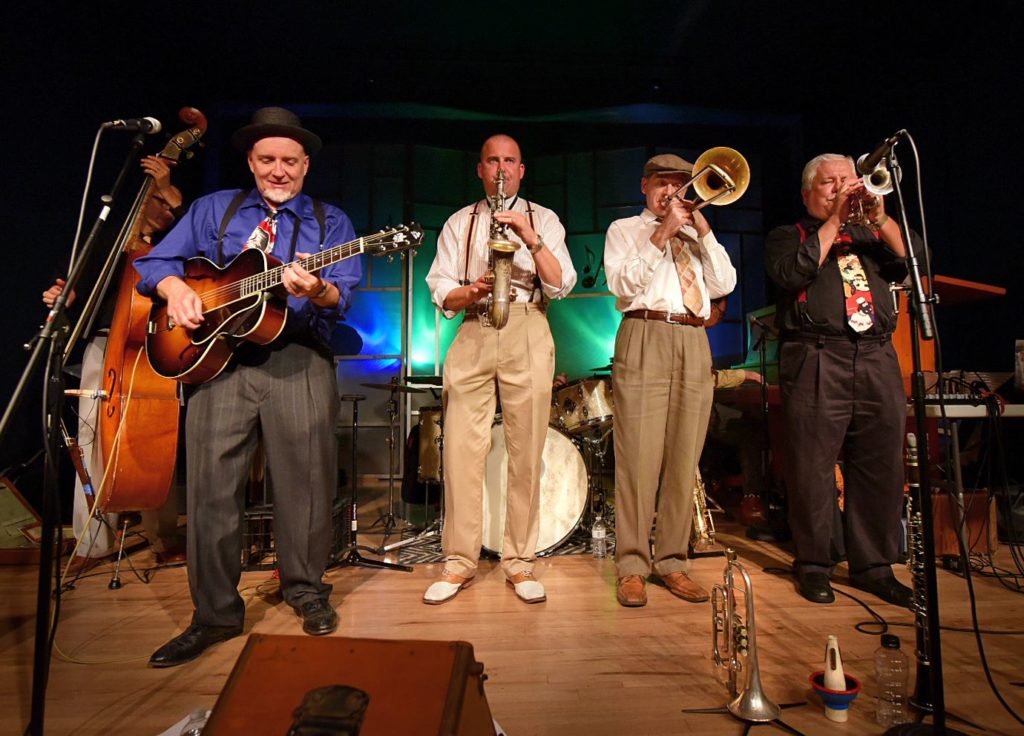
In the background, partially hidden: probably Josh Collazo on drums and Carl Sonny Leyland.
© Dave Stuckey and the Hot House Gang
Those who can’t attend one of their gigs can comfort themselves with How’m I Doin’?!, the band’s debut album recorded in 2015. It comprises twelve songs, half of which are from Stuckey’s pen.
As he did with his previous groups, it’s essential for Stuckey to contribute (he’d probably add ‘modestly,’ but don’t believe him ) to the genre by writing original and keeping this music relevant like any other genre. His songs fit perfectly next to the classics, which are Love Is All Around The Corner, I Never Knew (in a version probably inspired by the KXYZ Novelty Jazz Band), and T’Ain’ t No Use. There is also an adaptation of Maybe It’s The Blues by Georgia Tom Dorsey and the excellent instrumental Shim-Me-Sha-Wabble.
Dave Stuckey’s relaxed (ala Jack Teagarden) voice works wonders throughout, and the musicians compete in daring and creativity in the solos and arrangements. Additionally, the recording perfectly captures the sound and excitement of the band as if they were in their natural element: the stage. Too many good bands fail to convey their energy and vitality in the studio, resulting in a cold and sterile result. This is far from being the case here. It’s romping and swinging and instantly puts a smile on your face (although it can also move you with songs such as I Don’t Stand A Ghost Of A Chance or T’Ain’t No Use). It’s hard to pick a favorite track; this album is perfect from start to finish. Still, if I had to, I’d choose the Oriental-tinged Sister Kate (The Potentate Of Harlem), a distant cousin of Egyptian Ella, featuring excellent horn solos and beautiful arrangements, and Pardon My French. Stuckey has a knack for writing nifty and clever lyrics.
The pandemic period was a challenging time for the musicians who made a living out of live music. During the lockdown, Pappy performed a live show on Facebook each week for 16 weeks called Ten Tunes On Tuesday At Two. But it was more than economical; Stuckey missed the interaction with the audience and the dancers, who are, for him, an integral part of the performance.
Now that period is behind us, Dave Stuckey has resumed his live activities, playing with the Hot House Gang, a new western swing combo called the Four Hoot Owls, a larger band with Hal Smith named Pappy & Junior’s Western swing All Stars, the Dave and Deke Combo and a refurbished lineup of the Lucky Stars. If only he could find time to record some new material with the Hot House Gang!
This concludes the Dave Stuckey story. I tried to be as complete as possible (but I probably forgot a couple of things). Anyway, I hope you’ve learned a thing or two and that this article inspired you to dig into the rich discography of that man of multiple talents.
Fred “Virgil” Turgis
Dave Stuckey on the web:
Website – https://www.stuckeyville.net/
Bandcamp – https://stuckeyville.bandcamp.com/
Sources
All interviews by Fred Turgis except where noted.
– Liner Notes
The Dave & Deke Combo – There’s Nothing Like An Old Hillbilly– Bucket-Lid (2005)
– Book
Catch That Rockabilly Fever – Sheree Homer, McFarland (2010)
– Websites
https://www.latimes.com/socal/glendale-news-press/tn-gnp-dave-stuckey-and-his-hot-house-gang-are-stuck-on-old-school-jazz-20151024-story.html
https://syncopatedtimes.com/dave-stuckey-pass-the-swingin-music-pappy/ (I warmly recommend you to subscribe to the Syncopated Times)
https://www.discogs.com
This article is © Fred Turgis & the Rockabilly Chronicle.
And of course, thanks to Cuzzin’ Dave Stuckey for his time, patience, advices, music and friendship.
